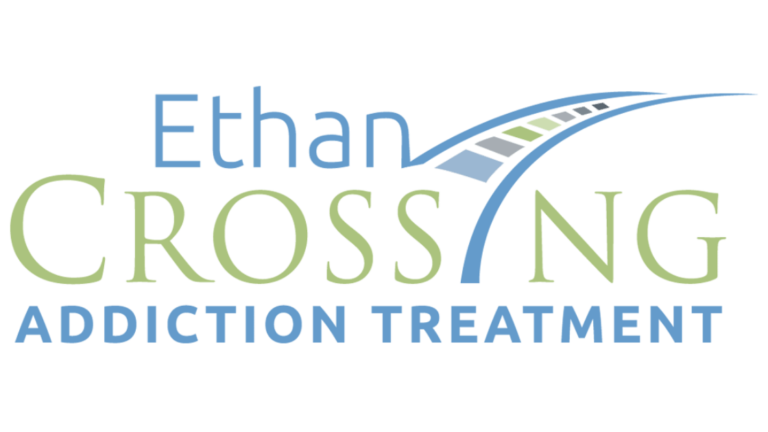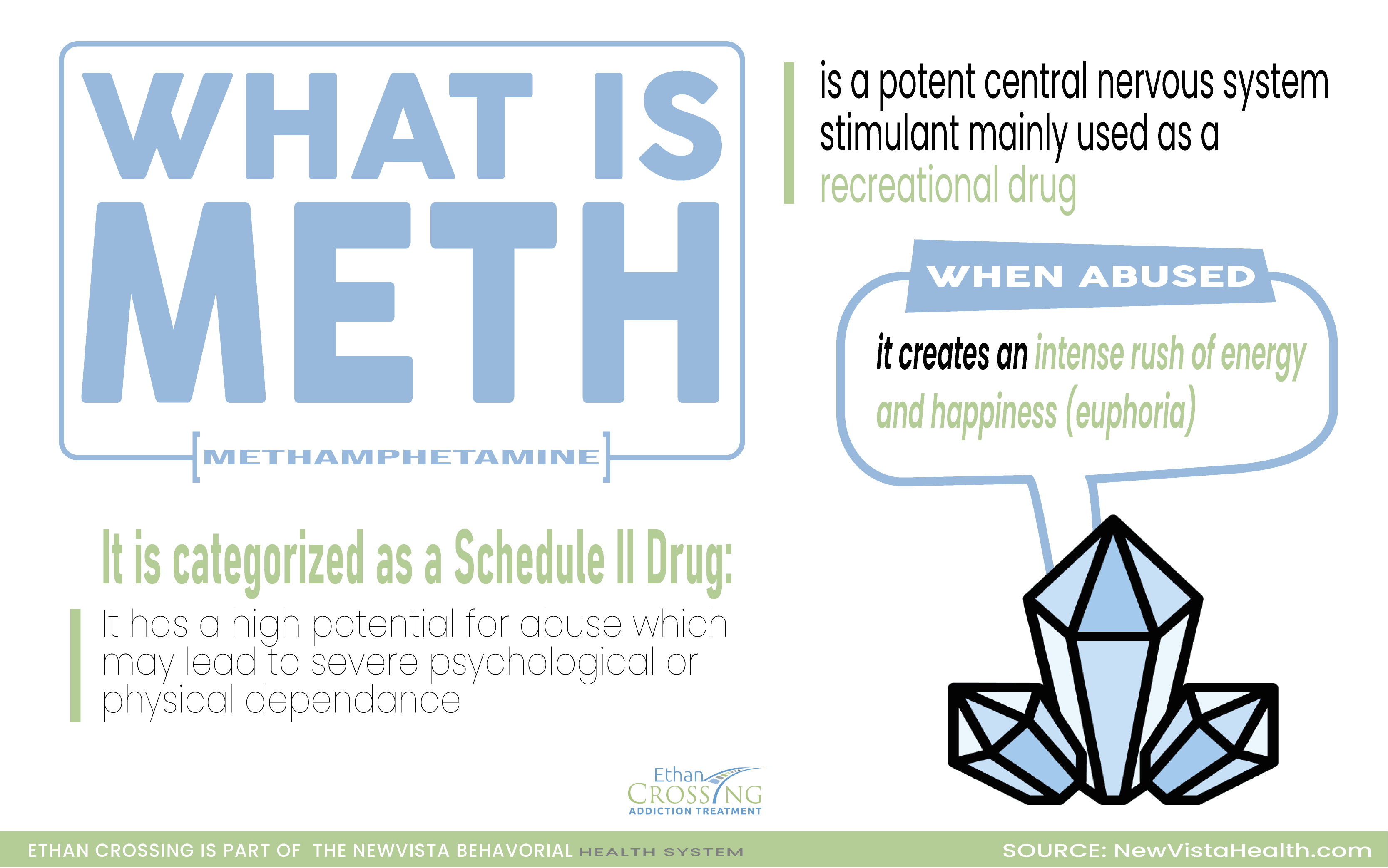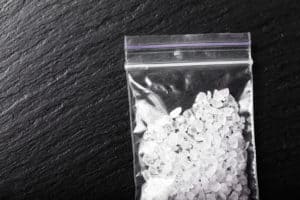Methamphetamine, or meth, is a highly addictive stimulant substance that affects the central nervous system (CNS). The CNS controls speech, walking, blinking, breathing, perceptions, emotions, and thoughts. That is why someone on meth will have trouble talking, walking, and thinking clearly. They may also seem to have extreme emotional responses and mood swings. Methamphetamine was once widely and legally available in tablet and injectable forms throughout the US. However, a large population abused these products for the stimulant effects; this prompted the FDA to restrict and regulate the drug as a Schedule II controlled substance in 1970.
You can use this image of “what is meth” with attribution linking to: https://newvistahealth.com/drugs/meth/
Jump To Section
What Does Meth Look Like?
Meth is a crystalline powder that is most commonly white, though it can also be yellow, pink, or brown. It is odorless, bitter, and dissolvable in liquid.
How is Meth Used?
It’s most commonly consumed via smoking, snorting, or injecting. Many times individuals will mix meth with other drugs like heroin, marijuana, alcohol or Xanax to counteract the extremely stimulating effects of methamphetamine.
Street Names For Meth?
Commonly used street names or slang terms for Meth Include the following:
- Glass
- Speed
- Ice
- Crystal
- Crank
- Tweak
- Chalk
How is Meth Used?
Meth can be taken orally, smoked, snorted or injected with a needle intravenously. Smoking meth is the most common way meth users ingest the drug. Smoking meth is the easiest way to use it and it actually has effects that are similarly as potent as injecting it which is not the case with other drugs. Many times meth is mixed with other substances like MDMA or heroin to enhance the effect of other drugs.
How Is Meth Smoked?
Meth can be smoked without having to change it or make it into powder. The hydrochloride salt of methamphetamine can be smoked directly, without having to add it to something else or change its form. When meth is smoked is known as crystal meth or “ice” as it looks like blue-white rocks.
How Is Meth Injected?
The process for shooting meth is similar to heroin. Users typically mix the crystals with a little bit of water until it dissolves. They then put cotton into the water and extract the substance into a needle. This form of abuse can leave users at risk of HIV and other contagious diseases.
Why Is Meth So Addictive?
When people use meth, they feel:
- More sociable
- More talkative
- Increased energy and become more active
- Less inclined to eat, making weight loss easy
- Euphoric
- A sense of well-being
When injected or smoked, the effects happen quickly but are short-lived. When snorted or taken orally, the euphoria happens within several minutes but is not nearly as intense.
As a person uses meth, it has an intense effect on dopamine, a chemical that affects the pleasure center of the brain. As the usage continues, the brain cannot make the dopamine until more meth is ingested. This creates a cycle of increased usage, an increase of the amount abused, and struggles to get the same high as they used to.
Long-Term Effects Of Meth Use
Abusing methamphetamines is detrimental to your physical health. The substance changes your brain in ways that may not be completely reversible. Effects of chronic meth abuse include:
- Aggressive and violent behavior
- Anxiety
- Insomnia
- Cardiovascular problems (heart attacks, irregular heartbeat, palpitations)
- Increased risk for HIV and hepatitis for those who inject meth
- Memory loss
- Mood swings
- Malnutrition
- Lung problems for those that smoke meth
- Seizures
- Sores on the skin
- Loss of teeth and gum damage
Methamphetamine: Frequently Asked Questions
-
What is ICD-10?
US overdose deaths involving pshychostimulants are classified under ICD-10 code: T43. 6, This category is dominated by methamphetamine related-overdoses.
-
Has Meth Production Slowed Down Since Covid-19 Started?
No, methamphetamine production has increased since January 2020. According to the Millennium Health Signals Report significant increases in covid 19 use and overdose rates started occuring in march of 2020.
-
How Is Meth Manufactured (Made)?
One of the reasons meth addiction has increased so much is the ability for it to be produced relatively easy without a farming or crop organization like marijuana, cocaine or heroin. It can be made easily in small clandestine laboratories using store bought chemicals.
Meth is often manufactured or “cooked” in very crude laboratories. Through a cooking process the pseudoephedrine or ephedrine is chemically changed into meth. Many of these labs are not sophisticated operations and do not require sophisticated chemistry equipment. The people who cook the meth usually do not have any chemistry training which makes ingesting meth very dangerous. Cooking meth is relatively simple, but highly dangerous and toxic.
There are two basic categories of meth labs:
Meth Superlabs:
Meth superlabs produce large quantities of meth and supply and are typically owned and operated by drug traffickers that sell the drug in communities across the U.S. Most of the larger labs are controlled by Mexican Drug Cartel and are operated in Mexico or some areas of the United States.
Small Toxic Meth Labs:
Many times these small toxic meth labs are out in the country away from towns where the smell does not travel so police will not find out. these small meth labs produce smaller quantities of meth and many times are set up in motels, automobiles or camping trailers.
-
What ingredients are in Meth?
The most common ingredient in meth is pseudoephedrine or ephedrine, commonly found in cold medicine. Psuedaphed is now monitored at most stores and if someone is purchasing the maximum amount of this type of cold medecine they may be questioned. The ingredient in meth can be extremely harmful to ones health and many times include: ether, paint thinner, Freon®, acetone, anhydrous ammonia, iodine crystals, red phosphorus, drain cleaner, battery acid, and lithium (which is taken from batteries).
Signs And Symptoms Of A Meth Addiction
As with any substance, there are signs and symptoms of a meth addiction to look out for. These include:
- Excessively chatty
- Strong cravings for meth
- Extreme weight loss
- Unable to stop using meth
- Mood swings
- Avoiding hobbies that once brought pleasure
- Excessive scratching at the skin that causes sores
- Unusual aggressive behavior
- Burns on fingers and lips from smoking meth
- Nosebleeds from snorting
- Track marks from injecting meth
- An unreasonable amount of energy
- Isolating from family and friends
- Dilated pupils
Meth Addiction Treatment & Rehab
Inpatient rehab for meth use is a great way to separate yourself from the substance while also receiving medical care, therapy, and clinical services to help reset your life. Exceptional treatment that is focused on getting to the core of the matter is one of the ways many individuals can recover from meth addiction. Each patient is a part of creating their addiction treatment plan so that we meet their individual needs. We offer aftercare planning and alumni support as they move through our programs. Contact us today to learn more about how we can help.
Get Help for Meth Addiction Today
If you are struggling to stop using methamphetamines, residential drug and alcohol treatment may be the best option.
Without a group of people to function as a support system and a structured program to develop coping skills, the methamphetamine rehabilitation process will be much more difficult.
Fortunately, our rehab programs help you create this support network and provide the necessary tools for sustained recovery. If you or a loved one have an addiction to meth, you can start the admissions process today.











